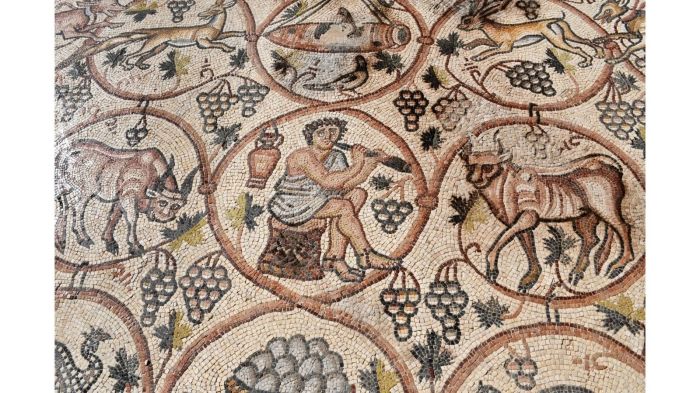
One of the most spectacular mosaics ever found in Israel is now on display to the public for the first time. The Be’er Shema (Birsama) mosaic was discovered almost 35 years ago near Kibbutz Urim in the Negev Desert, and is believed to be approximately 1,600 years old.
“This is a unique mosaic from the Byzantine period (324-638 CE),” said Shaike Lender, one of the archaeologists who excavated the site together with Dan Gazit. “It presents 55 richly detailed medallions — with mythological characters, baskets of fruit, exotic animals, scenes from everyday life, hunting scenes and more. The mosaic was clearly made by the hand of a true artist. It is comprised of small mosaic stones in a variety of colors, combined with glass and pottery to infuse it with variety.”
Artisans from the Byzantine era originally created the stunning mosaic, made up of multiple circles with intricate designs inside, to decorate a monastery. Archaeologists excavating the ruins found a large winepress and warehouses with storage jugs, indicating that the monastery once produced wine as a means of income.
Ami Shahar, Conservation Department head at the Israel Antiquities Authority, explained what had happened to the mosaic since it was first found in 1990.
“Over the ensuing years since its discovery, the mosaic floor’s state of conservation deteriorated. Given this situation, actions were taken. It was re-exposed, treated and strengthened, and transferred from its original exposed location to the Merhavim Council's enclosed compound. Now, it is fully protected from agricultural and development work, and at long last, it is presented to the public to appreciate,” he announced. “Upon completion of our expert team’s intensive efforts, the results enable the public to view and appreciate a spectacular 1,600-year-old work of art.”
The opening ceremony took place at the Merhavim Regional Council complex on Monday. Heritage Minister Mk Amichai Eliyahu, Merhavim Regional Council Head Shai Hajaj, and Israel Antiquities Authority Director Eli Escusido were all in attendance, together with local students and community members from the area.
The event included a presentation of the mosaic itself, along with archaeological activities, creativity booths, and planting new seedlings out in nature, according to a press release from the Israel Antiquities Authority.
According to Eli Escusido, Israel Antiquities Authority Director: “The event was held as part of the ‘Antiquities Right at Home’ project developed and managed by the Israel Antiquities Authority and the Israel Ministry of Heritage, which seeks to make the legacies of the past extant in urban areas to be accessible to the public. Especially in these days, it is of great importance to reveal historical gems in the Gaza Envelope region (Otef), such that they will be visitor attractions and increase traffic to this vital area.
This new site will serve the public as an open archaeological garden. Explanatory signs, an access road and seating areas were integrated into the site. I now invite the public to enjoy and to form their own impressions of one of the most beautiful mosaics ever seen here in Israel’s South, here in the northwestern Negev."
Merhavim Regional Council Head Shay Hajaj said: “This beautiful mosaic, a living testimony to life that existed in the Negev some 1,500 years ago, will be preserved here and become a focal point for visits and learning — for tourists, students, and residents from across the country. It is another chapter in the story we are writing here in Merhavim – a story that connects past, present, and future.”
“It seems that the ancient road upon which this settlement was sited served as a kind of border between the desert and the inhabited part of the country — during the Byzantine period, and perhaps serving as such even earlier, during the Roman period,” surmised Lender, who originally helped uncover the mosaic from under a meter and a half of earth.
“This road is actually the ancient Nabataean-Roman spice trail through the desert — at this point, on the axis connecting Halutza in the Negev with the port of Gaza. The excavation showed that this was indeed a large settlement, on the order of several hundred dunams, that served travelers needing a safe place to spend the night, offering protection from potential attacks by raiders from the local Bedouin tribes.”
The Byzantine masterpiece will continue to be on display to the public in the Merhavim Regional Council headquarters in the Negev, just east of the Gaza Strip.
This article was originally published by All Israel News.